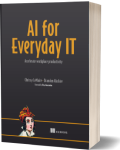AI for Everyday IT
Artificial Intelligence
Book Details
Book Title
AI for Everyday IT
Author
Chrissy LeMaire, Brandon Abshire
Publisher
Manning Publications
Publication Date
2025
ISBN
9781633436428
Number of Pages
378
Language
English
Format
File Size
4.9MB
Subject
AI in IT Operations (AIOps)
Table of Contents
- AI for Everyday IT
- brief contents
- contents
- foreword
- preface
- acknowledgments
- about this book
- Who should read this book
- How this book is organized: A road map
- About the code
- Software requirements
- liveBook discussion forum
- Other online resources
- about the author
- about the cover illustration
- Part 1 Introduction to AI
- 1 Artificial intelligence in IT
- 1.1 Generative AI changes everything
- 1.2 The elephant in the server room
- 1.3 Strengthening your skill set
- 1.4 An introduction to generative AI
- 1.5 Service costs
- 1.6 Using AI responsibly at work
- 1.7 How we are using AI
- 1.8 Prompts used in this chapter
- Summary
- 2 Chatbots: Tasks and tips
- 2.1 Chatbots and conversational AI
- 2.2 Text-to-image AI models
- 2.3 Prompts used in this chapter
- 2.4 Summary
- 3 Basic intelligence
- 3.1 Defining the terms
- 3.2 Everything you never wanted to know about tokens
- 3.3 When good bots go bad
- 3.4 Free vs. premium accounts
- 3.5 Prompts used in this chapter
- Summary
- 4 Prompt engineering and problem formulation
- 4.1 Prompt engineering
- 4.2 The spectrum of AI prompting
- 4.3 The mechanics of a good prompt
- 4.4 Introductory prompts for IT roles
- 4.5 Advanced techniques
- 4.6 Best practices and common mistakes
- 4.7 Problem formulation
- 4.8 Incorporating problem formulation
- 4.9 Prompts used in this chapter
- Summary
- 5 Prompts in action
- 5.1 Prompt engineering in action
- 5.2 Problem formulation in action
- Summary
- 6 Document handling
- 6.1 Best practices for document handling with AI
- 6.2 Ethics in AI document handling
- 6.3 Document summarization
- 6.4 Format conversion
- 6.5 Text extraction from images
- 6.6 Document comparison
- 6.7 Document classification and tagging
- 6.8 Document anonymization
- 6.9 Language translation
- 6.10 Prompts used in this chapter
- Summary
- 7 Emails and instant messaging in the workplace
- 7.1 Enhancing email management with AI
- 7.2 Using AI in instant messaging
- 7.3 Integrations and automation with AI
- 7.4 Improving your writing while maintaining your voice
- 7.5 Maintaining critical thinking and good judgement
- 7.6 The future of AI communications
- 7.7 Prompts used in this chapter
- Summary
- Part 2 IT operations and AI
- 8 IT support and service desk
- 8.1 Service desk therapy
- 8.2 Technical support
- 8.3 Custom GPTs
- 8.4 The future of the service desk: Agents
- 8.5 Prompts used in this chapter
- Summary
- 9 Systems administration
- 9.1 Change request
- 9.2 More distros, more problems
- 9.3 Multiserver administration
- 9.4 Renaming files
- 9.5 Analyzing error logs: Identifying exceptions and failures
- 9.6 Automating tasks for efficiency and compliance
- 9.7 Auditing configuration files with AI
- 9.8 Existing AI in systems engineering
- 9.9 Prompts used in this chapter
- Summary
- 10 Database administration and development
- 10.1 Query and object creation basics
- 10.2 Query optimization
- 10.3 Code documentation
- 10.4 Heterogeneous database environments
- 10.5 Maintenance jobs
- 10.6 Advanced administration
- 10.7 Prompts used in this chapter
- Summary
- Part 3 Development and AI integration
- 11 Code assistants and development tools
- 11.1 Privacy and security
- 11.2 Understanding the value of existing skills
- 11.3 GitHub AI suite
- 11.4 Cline
- 11.5 Cursor AI
- 11.6 Google Project IDX
- 11.7 Aider
- 11.8 Summary comparison of code assistants
- 11.9 Best practices for AI-assisted development
- 11.10 Prompts used in this chapter
- Summary
- 12 AI in DevOps engineering
- 12.1 Practical AI use cases in DevOps
- 12.2 Upgrading nearly 7,000 tests: A real-world AI project
- 12.3 The GenAIOps lifecycle
- 12.4 Prompts used to write this chapter
- Summary
- 13 Building AI-powered applications
- 13.1 Function calling
- 13.2 The functions
- 13.3 Validating SQL queries with examine_sql
- 13.4 Practical applications and security considerations
- 13.5 Prompts used in this chapter
- Summary
- Part 4 Leadership and growth with AI
- 14 Conflict resolution and crisis management
- 14.1 Addressing workplace conflicts
- 14.2 Crisis management
- 14.3 Prompts used to write this chapter
- Summary
- 15 Management essentials
- 15.1 Policies and benefits
- 15.2 Career development and growth
- 15.3 Performance reviews
- 15.4 Prompts used in this chapter
- Summary
- 16 Management interventions
- 16.1 Management intervention guidelines
- 16.2 Team cohesion
- 16.3 Interviewing candidates
- 16.4 Time management for the hands-on technical manager
- 16.5 Prompts used in this chapter
- Summary
- 17 Career advancement
- 17.1 Leading AI adoption in the organization
- 17.2 Training and certifications
- 17.3 External career advancement
- 17.4 Ethical considerations and best practices
- 17.5 Putting it all together
- 17.6 Prompts used in this chapter
- Summary
- appendix A Local AI models: An accessible alternative
- A.1 Getting your hardware ready
- A.2 Tools for simplifying local AI setup
- A.3 Popular local AI models
- A.4 Bringing it all together: Security and ethical considerations
- appendix B OpenAI GPT Actions
- B.1 A practical example: Using database monitoring APIs
- B.2 Real-world example: Using GPT Actions with the OpenAI API
- B.3 Security considerations for GPT Actions
- B.4 Combining GPT Actions with function calling
- index
- AI for Everyday IT - back
